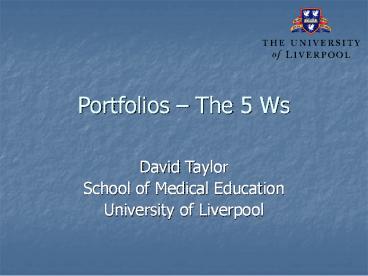Portfolios - PowerPoint PPT Presentation
Title:
Portfolios
Description:
Portfolios The 5 Ws David Taylor School of Medical Education University of Liverpool – PowerPoint PPT presentation
Number of Views:115
Avg rating:3.0/5.0
Title: Portfolios
1
Portfolios The 5 Ws
- David Taylor
- School of Medical Education
- University of Liverpool
2
The five Ws
- Who
- What
- Where
- When
- hoW
3
Why ?
- There are many ways of assessing knowledge and
skills - But we need some way of recording activities
- And developing and demonstrating appropriate
attitudes
4
Who
- Our course is five years long, and is followed by
two years in foundation posts before the Doctor
is fully registered and allowed to practice
independently.
5
Who (2)
- We currently use portfolios in years 1,3 5 of
the undergraduate course F1, F2 - And for consultants, academics and anyone
seeking promotion
1 2 3 4 5 F1 F2
6
What is a portfolio
- It is a collection of documents
- Supported by a commentary
- It can be electronic
- more convenient in the University context
- It can be on paper
- More convenient in the clinical context
7
What documents?
- It depends on the reason for the portfolio!
- Diaries
- Log-books
- Case notes
- Examination results
- Longer discursive pieces
8
Dewey (1933)
- Reflection is
- A purposeful form of thought provoked in learners
when they recognize that their understanding is
incomplete.
9
In order to reflect
- 3 things are needed
- something to reflect on
- reflection time modelling
- motivation
- Albanese,2006,Medical Education 40288-290
10
What sort of commentary?
- Technical
- What and how of practice
- Facts and theories
- Audit
- Practical
- How decisions are made
- Articulate concerns
- Resolve professional dilemmas
- Critical
- Social and political context and constraints
11
What is included
- The portfolios all include examination results
and the student commentary on them. - In the first year they also include reflection on
settling in and adjusting to University life. - In the third year they include reflections on
professional attitudes students have experienced
or observed.
12
(No Transcript)
13
(No Transcript)
14
(No Transcript)
15
(No Transcript)
16
What is included in later years
- In fifth and subsequent years they also include
reflection on particular cases/treatment regimes - In F1/F2 and beyond they will include reflection
upon critical incidents
17
Final year PETA
18
Final year PETA Bottom half
19
When
- Right from the start and often
- Habit helps
- Novelty is important
- So we focus on different things each year
- Settling in, clinical experiences, ethical
behaviour, evidence base to medical practice,
audit, future plans, critical incidents - It has to be relevant
- In the clinical arena it will focus on cases
determined by the agreed learning outcomes
20
Where
- Wherever the student works
- In the first/second year this is often at the
computer, so we use electronic portfolios - In the UK the hospital computers wont talk to
the internet, so where a VPN cant be set up we
use. - Paper, and interviews, formal and informal, with
the educational supervisors
21
How
- How is it assessed?
- Through discussion with a supervisor
- The whole thing?
- The reflective component?
- Parts chosen by the student?
- Parts chosen by the supervisor?
22
Marks?
- Best practice currently is to use criteria rather
than a checklist - The criteria need aggregating in domains
- KSA
- Burch, Seggie and Gary 2006 SAMJ 96430-433
- The number of raters needed for validity depends
on the criteria and the domains - Roberts et al.,2006 Med Educ 40363-370
23
How (2)
- It is the main form of assessment for our final
year students. - They sit finals at the end of their fourth
year. - Their final year is a clinical apprenticeship,
assessed through the portfolios. - 5 different assessors (3 meetings each - plus
referees in the case of difficulty/expected
difficulty) - Mid-Year portfolio review (all borderline/fails
and sample of others) - End of year review of borderline/fails
24
Benefits
- Allows the student to demonstrate insight and
understanding - Allows student and staff to observe development
and progress - Models the real world
- Goes one step beyond the competencies model
in developing professionalism - Provides a focus (and evidence) for the
discussion between student and doctor
25
F1
26
Staff
27
David Taylors response..































